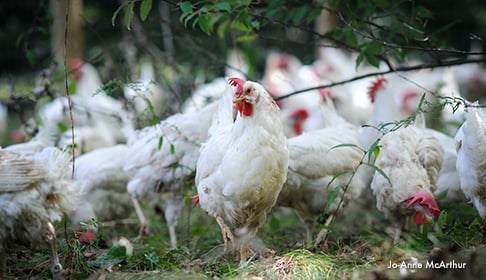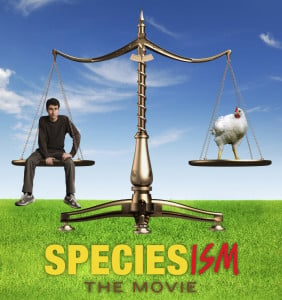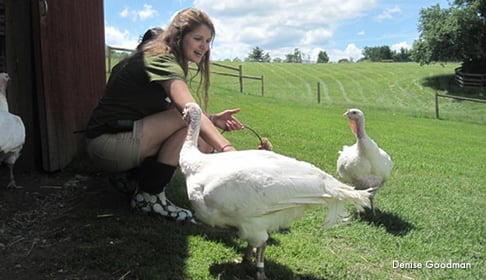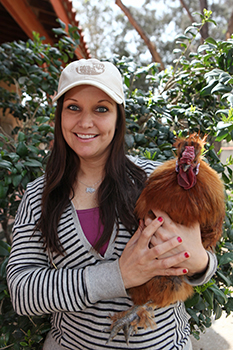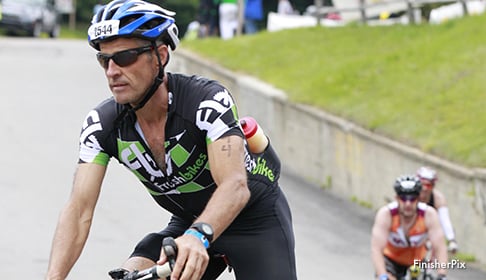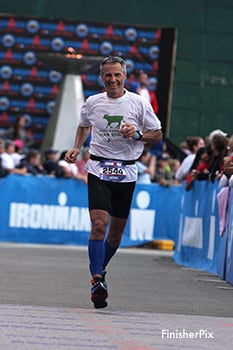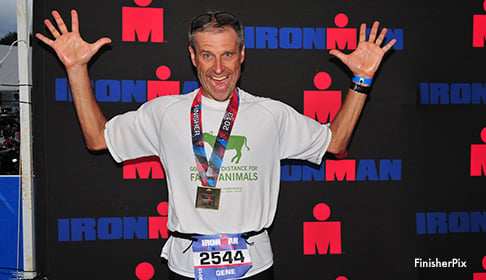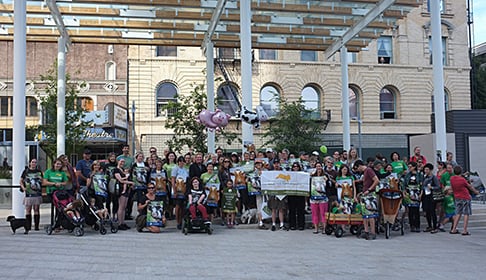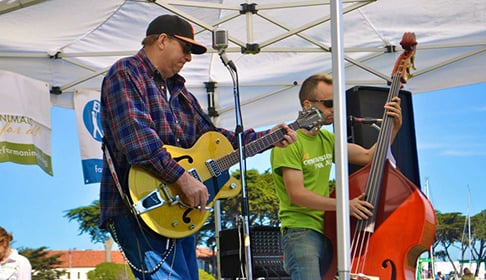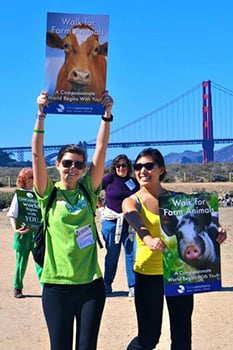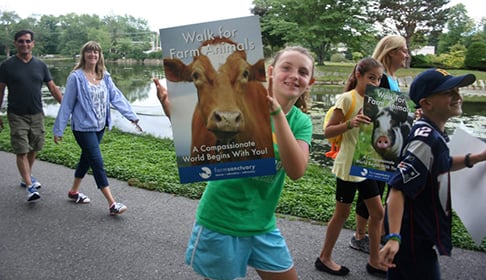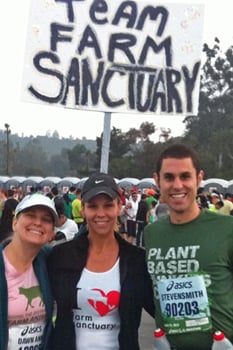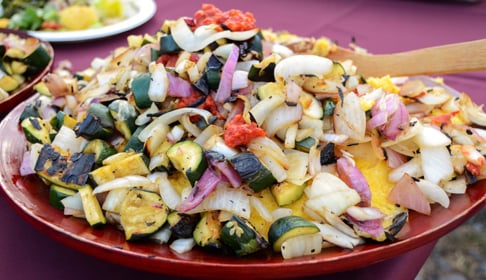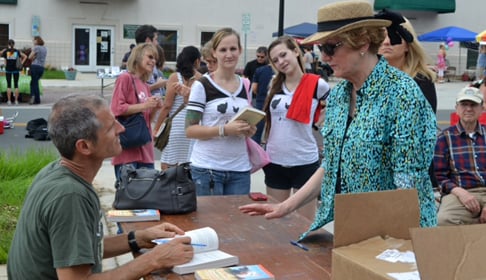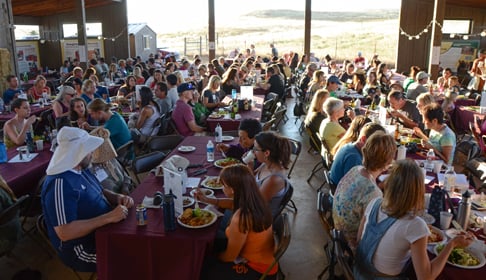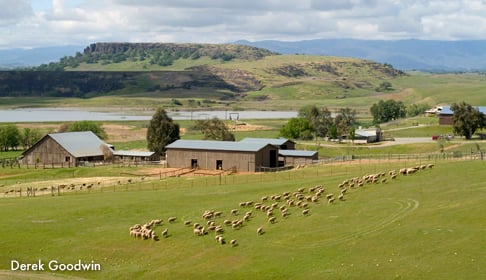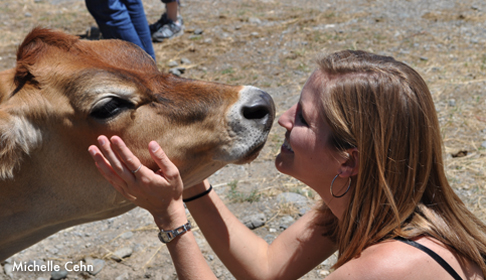The Ghosts in Our Machine is a film about a complex social dilemma. As described on the film’s website, humans have cleverly categorized non-human animals into three domains: domesticated pets, wildlife, and the ones we don’t like to think about — the “ghosts in our machine.” During production in 2012, our national shelter director, Susie Coston, sat down with director Liz Marshall to talk about the film. The Ghosts in Our Machine will soon enjoy its theatrical release in the United States, starting in New York, November 8–14, at the Village East Cinema and in the Los Angeles area, November 15–21, at Laemmle Theatre, Music Hall 3, in Beverly Hills. For more information and show locations, visit the film’s website.
This post was originally published on March 12, 2012.
By Susie
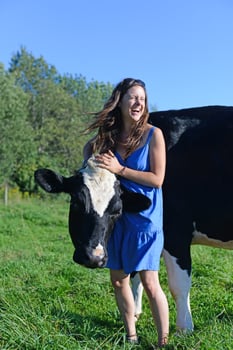
Photojournalist Jo-Anne McArthur with her pal, Sonny.
I often meet artists who are passionate about animal causes, and I love introducing them to the animals who call Farm Sanctuary home. Over the last year or so, we’ve been especially fortunate to get to know filmmaker Liz Marshall, and I want to share her upcoming project, The Ghosts in Our Machine, with you. Ghosts, as we often call it, is a documentary that follows the work of photographer and animal advocate Jo-Anne (Jo) McArthur, and it features some Farm Sanctuary residents. Here’s what Liz had to say when I asked about her work and Jo’s:
Susie: What is The Ghosts in Our Machine?
Liz: Well, with the exception of our cats and dogs and a few wild and stray species within our day-to-day living environments, we primarily encounter animals as food, clothing, research, and entertainment.
We don’t fully realize how and where our lives intersect with animals, and that makes these animals “ghosts” in our modern world. The Ghosts in Our Machine is a feature-length film that illuminates the lives of these “ghosts” — individual animals, hidden from our view, living within or rescued from the consumer-driven machine.
Through the heart and photographic lens of animal rights protagonist Jo-Anne McArthur, we become intimately familiar with a small cast of animal characters. These individuals represent just a few of the countless animals we too often unknowingly affect in devastating ways. We hear from a spectrum of voices about the cognitive and emotional complexity of animals and about globalized animal industries — scientists, doctors, and industry representatives also contribute to the story.
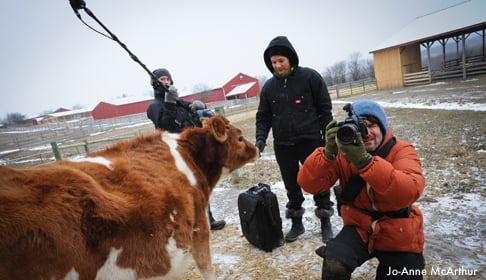
Filming at our New York Shelter.
Susie: How did you and Jo decide to work together on this project?
Liz: Working with Jo is a natural fit since we are both longtime documentarians committed to social justice. Jo’s photographic body of work, We Animals, initially inspired me, and then I quickly realized it would make an interesting story to feature Jo-Anne as the main human subject of a film.
I approached Jo in early 2009 about the possibility of collaborating on a feature documentary, but it wasn’t until later in 2010 that things fell into place. In this project, Jo’s lens is an intimate, honest portal into the lives of these “ghosts,” and she is at a critical juncture in her own activist–photographer career. While Jo’s work is celebrated within the worldwide animal rights community, it’s a treasure not known to a wider audience.The animals’ stories involve struggle, and Jo’s does too.
Part of the story follows Jo as she works with her photo agency in New York City to pitch her work to mainstream publications. Her work is happening at a time when issues pertaining to animal rights are in the public eye — there is a groundswell of consumer interest in health and compassion. But, while we’re seeing these issues gain a foothold in popular culture, the animal rights movement, itself, is often misunderstood and marginalized. People still do not want to “see” how their consumer behavior affects billions of animals. The film reflects this wave of consciousness and conflict and is also part of it.
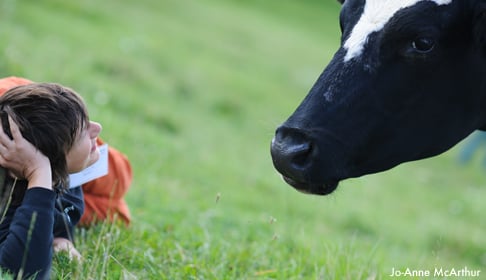
Filmmaker Liz Marshall with Fanny.
Susie: How did your connection with Farm Sanctuary come about?
Liz: We (Ghosts Media) are so excited about our growing relationship with Farm Sanctuary. My introduction to the sanctuary was a very magical, unforgettable visit in 2004. It naturally inspired one of the stories featured in the film: the rescue and rehabilitation of Sonny.
This story highlights the realities of the dairy and veal industries and the very special work that Farm Sanctuary does. Jo is a close friend of Farm Sanctuary — as she says in the film, “It is my home away from home.” It’s thanks to Jo that we’ve had such access to the sanctuaries and the animals.
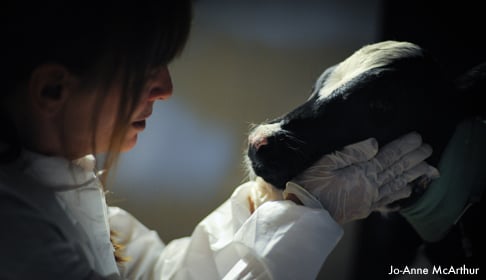
National Shelter Director Susie Coston with Sonny shortly after his rescue.
Susie: What do people most need to know about farm animals and our food system?
Liz: I love Bruce Friedrich’s [Farm Sanctuary Senior Director for Strategic Initiatives] ongoing Facebook messaging — he posts an image of a farm animal and says “Someone, not Something.” This about sums it up for me. The animals we use for food, research, clothing, and entertainment are individuals who possess emotions and intelligence; they are not inanimate objects. Like many social movements, animal rights can feel like an upward battle, but it is helping to expand compassion in our world. Slowly but surely, these “ghosts” will become known in the consciences of many, many consumers.
Watch the trailer below or visit theghostsinourmachine.com:

 We had been preparing for this moment since mid-August, when Animal Place, a rescue organization in Grass Valley, California, contacted us. They were set to save 3,000 hens scheduled to be gassed to death at an egg factory. All chickens used in industrial egg production are gassed or slaughtered once their productivity declines, typically at about two years old. These particular birds had been kept in battery cages, the most common egg production method in the United States and the system for confining more than 250 million hens each year. Their cages were housed in giant sheds and stacked several rows high. Inside, the hens were crowded together so tightly that they couldn’t even stretch a wing. They were forced to stand and lie on wire floors without relief. Feces from the hens above fell upon them constantly. The air they breathed was thick with dust and ammonia. Every day was a torment. Now, though, relief was finally in sight for these few hens.
We had been preparing for this moment since mid-August, when Animal Place, a rescue organization in Grass Valley, California, contacted us. They were set to save 3,000 hens scheduled to be gassed to death at an egg factory. All chickens used in industrial egg production are gassed or slaughtered once their productivity declines, typically at about two years old. These particular birds had been kept in battery cages, the most common egg production method in the United States and the system for confining more than 250 million hens each year. Their cages were housed in giant sheds and stacked several rows high. Inside, the hens were crowded together so tightly that they couldn’t even stretch a wing. They were forced to stand and lie on wire floors without relief. Feces from the hens above fell upon them constantly. The air they breathed was thick with dust and ammonia. Every day was a torment. Now, though, relief was finally in sight for these few hens. An anonymous donor, who paid for the birds to be flown from the west coast to the east coast, made this transport possible. Chickens who have been used for egg production are very fragile, so we were anxious about them making such a long trip. Considering the loading of the birds into crates, the trip to the airport from their original location, the flight time, and then the unloading and driving to our Watkins Glen Sanctuary, the birds spent well over 16 hours in transit. They were exhausted and in need of fresh food and water. Because they traveled in a cargo plane, the hens could not be viewed during the flight, and we were concerned as we waited to see them. As soon as we could reach them, we were delighted to learn that all had survived the trip, and we carefully removed each crate from the plane and loaded the hens into trailers and our transport van.
An anonymous donor, who paid for the birds to be flown from the west coast to the east coast, made this transport possible. Chickens who have been used for egg production are very fragile, so we were anxious about them making such a long trip. Considering the loading of the birds into crates, the trip to the airport from their original location, the flight time, and then the unloading and driving to our Watkins Glen Sanctuary, the birds spent well over 16 hours in transit. They were exhausted and in need of fresh food and water. Because they traveled in a cargo plane, the hens could not be viewed during the flight, and we were concerned as we waited to see them. As soon as we could reach them, we were delighted to learn that all had survived the trip, and we carefully removed each crate from the plane and loaded the hens into trailers and our transport van.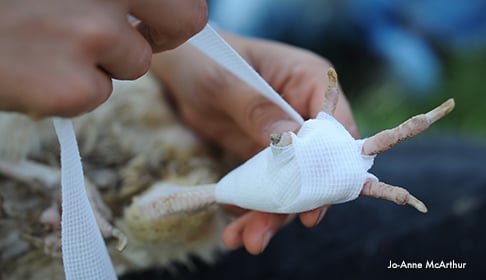 The evidence of the hens’ ordeal in industrial production was everywhere: lice infestations, respiratory ailments, prolapses from laying so many large eggs, impacted oviducts, peritoneal fluids, pus filled cysts, bumble foot infections, and mangled toes, which probably occurred when their extremely long nails became caught in the cage wire. It is so painful to think of these chickens, not only miserably crowded and frustrated, but also suffering for weeks or months with these painful, untreated ailments as parasites crawled all over their bodies. Sadly, these health problems are common in chickens at industrial egg farms, where individual attention is unheard of. One-hundred-and-fifty birds were identified with health issues requiring special treatment that would prohibit them from traveling to other sanctuaries right away.
The evidence of the hens’ ordeal in industrial production was everywhere: lice infestations, respiratory ailments, prolapses from laying so many large eggs, impacted oviducts, peritoneal fluids, pus filled cysts, bumble foot infections, and mangled toes, which probably occurred when their extremely long nails became caught in the cage wire. It is so painful to think of these chickens, not only miserably crowded and frustrated, but also suffering for weeks or months with these painful, untreated ailments as parasites crawled all over their bodies. Sadly, these health problems are common in chickens at industrial egg farms, where individual attention is unheard of. One-hundred-and-fifty birds were identified with health issues requiring special treatment that would prohibit them from traveling to other sanctuaries right away. On day 3, Mike Stura (who rescued our friend
On day 3, Mike Stura (who rescued our friend 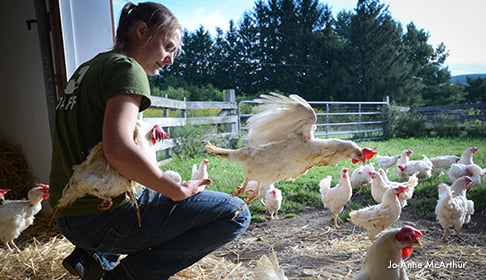 Just this week, the state vet came out to perform blood tests on those birds traveling to Virginia. Our health-care team drew blood on 50 of the hens who were banded with official state leg bands for legal entry into that state. These birds will be going to United Poultry Concerns, before the end of September, we hope. Twenty more hens were re-tested as well and will be heading to VINE Sanctuary in Vermont today.
Just this week, the state vet came out to perform blood tests on those birds traveling to Virginia. Our health-care team drew blood on 50 of the hens who were banded with official state leg bands for legal entry into that state. These birds will be going to United Poultry Concerns, before the end of September, we hope. Twenty more hens were re-tested as well and will be heading to VINE Sanctuary in Vermont today.